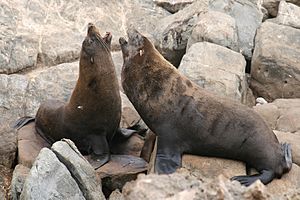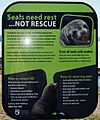New Zealand fur seal facts for kids
Quick facts for kids New Zealand fur seal |
|
|---|---|
 |
|
| Conservation status | |
| Scientific classification | |
| Genus: |
Arctocephalus
|
| Species: |
forsteri
|
 |
|
| Distribution of the New Zealand fur seal | |
The New Zealand fur seal (Arctocephalus forsteri) is a type of fur seal mostly found around southern Australia and New Zealand. They are also called the Australasian fur seal, South Australian fur seal, Antipodean fur seal, or long-nosed fur seal. These amazing marine mammals are known for their thick fur and playful nature. They spend much of their lives in the ocean but come ashore to rest, breed, and raise their pups.
Contents
About New Zealand Fur Seals
New Zealand fur seals are a type of pinniped, which means "fin-footed." This group includes seals, sea lions, and walruses. Fur seals are special because they have visible ear flaps and can turn their back flippers forward. This helps them walk on land. They are very agile in the water, using their strong front flippers to swim.
Where Do They Live?
New Zealand fur seals live in the cool waters of the southern Pacific Ocean. You can find them along the coasts of New Zealand, including its main islands and smaller offshore islands. They also live in southern Australia, especially around Tasmania, South Australia, and Western Australia. They prefer rocky coastlines and islands where they can easily climb out of the water.
What Do They Look Like?
New Zealand fur seals have a streamlined body shape, perfect for swimming. They are covered in two layers of fur: a dense, soft undercoat for warmth and longer, coarser guard hairs that protect them. Their fur is usually dark brown or grey on their backs and lighter on their bellies.
Size and Weight
Male fur seals are much larger than females. Adult males can grow up to 2.5 meters (about 8 feet) long and weigh between 120 to 180 kilograms (265 to 397 pounds). Females are smaller, reaching about 1.5 meters (5 feet) in length and weighing 30 to 50 kilograms (66 to 110 pounds). Pups are born small, weighing only about 3 to 5 kilograms (7 to 11 pounds).
Their Special Nose
One of their common names, "long-nosed fur seal," comes from their pointed snout. This gives them a distinct look compared to other seals. They also have long whiskers, called vibrissae, which are very sensitive. These whiskers help them find food and navigate in the dark ocean waters.
What Do They Eat?
New Zealand fur seals are carnivores, meaning they eat meat. Their diet mainly consists of fish, squid, and octopus. They are skilled hunters and can dive deep into the ocean to catch their prey. They often hunt at night, using their excellent eyesight and whiskers to find food.
Hunting Habits
These seals are very efficient hunters. They can hold their breath for several minutes and dive to depths of over 100 meters (330 feet). They use their sharp teeth to grab slippery prey. Sometimes, they even eat small penguins or seabirds if they get the chance.
Life Cycle and Reproduction
New Zealand fur seals gather in large groups called colonies during the breeding season. This usually happens from November to January. Males arrive first to establish their territories.
Birth of Pups
Female seals give birth to a single pup each year. The pups are born on land and are covered in a thick, black fur coat. They are completely dependent on their mothers for milk and protection. Mothers will stay with their pups for about 7 to 10 days before going out to sea to feed. They return regularly to nurse their pups.
Growing Up
Pups are nursed for about 8 to 10 months, sometimes even longer. During this time, they learn important skills like swimming and hunting from their mothers and other seals in the colony. They gradually start to eat solid food as they get older. Young seals will stay in the colony for a while before heading out on their own.
Lifespan
New Zealand fur seals can live for a long time. Females typically live for about 14 to 17 years, while males have a slightly shorter lifespan, usually around 10 to 12 years.
Are They in Danger?
New Zealand fur seals were once hunted for their fur and oil, which greatly reduced their numbers. However, they are now protected by law in both New Zealand and Australia. Their population has been growing steadily since hunting stopped.
Conservation Status
The International Union for Conservation of Nature (IUCN) lists the New Zealand fur seal as "Least Concern." This means their population is stable and not currently at risk of extinction. However, they still face threats like entanglement in fishing nets, pollution, and climate change affecting their food sources. Scientists continue to monitor their numbers and health to ensure they remain safe.
Images for kids
-
Arctocephalus forsteri near Kaikoura, New Zealand
-
at Castlepoint, New Zealand
See also
 In Spanish: Lobo marino de Nueva Zelanda para niños
In Spanish: Lobo marino de Nueva Zelanda para niños








